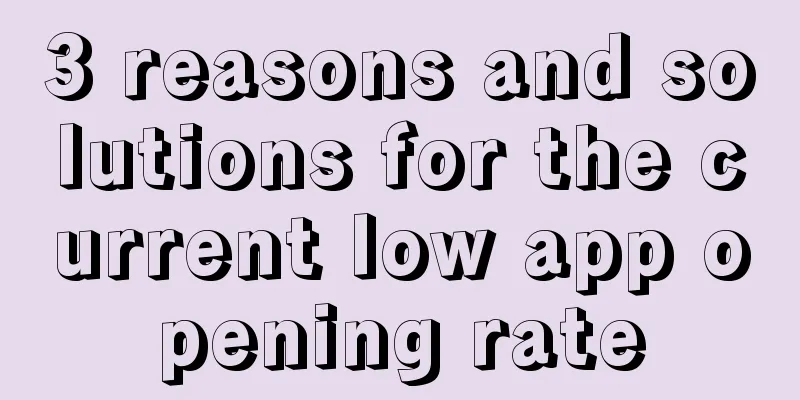3 reasons and solutions for the current low app opening rate

|
The open rate is a KPI indicator that all operations pay attention to. For example, an app, a WeChat tweet, a PUSH message, an EDM email, etc., only when the user opens it can the subsequent marketing content generate value. At a time when app opening rates are generally low, how to increase app opening rates is one of the issues that operations must consider every day. What is app open rate? The so-called app opening rate, in simple terms, is the probability of a user opening the app, that is, the average number of users who open the app divided by the total number of users who install the app. A website, an app, a WeChat article, an email, an event, a PUSH message, all have open rates. For example, the email open rate refers to the average number of emails opened divided by the total number of emails delivered; the WeChat picture and text message open rate refers to the average number of picture and text messages opened divided by the total number of picture and text messages delivered. If users do not open the app, there is no way to talk about subsequent page visits, retention , user activity, etc. Therefore, a high opening rate means a high app usage rate, and the content within the app has the potential to realize its marketing value. This is why app developers and app operators regard open rate as one of the more critical KPI indicators. However, the statistics of user usage data from the Android App Market show that the opening rate of apps is getting lower and lower, especially for some enterprise apps, of which only 0.2% are frequently opened and used by users (opened more than twice a week). Some users even frequently download apps, use them once and then uninstall them. So what are the reasons for the low app opening rate? How to solve these problems? Analysis of reasons for low app opening rate and countermeasures 1. App functions cannot meet user needs Users download and install apps mainly to obtain the information they are interested in. However, the function settings of some apps are too simple, especially some enterprise-level apps, whose functions are mainly to display information such as company introduction, development history, and corporate news, and cannot bring users a deeper experience and satisfaction. Countermeasures: Enrich functions or provide users with extreme functions Since users feel that there are too few functions, or the functions within the app cannot provide them with useful information, app developers or operators can consider enriching the functions of the app or creating a function that can provide users with the ultimate experience. As shown in the figure below, a traditional fruit and vegetable company has improved fruit and vegetable information, fruit and vegetable knowledge, coupons and other functions in its own app, which not only gained a large number of loyal users, but also increased the business volume of traditional channels . 2. The user is asleep According to the analysis of the app user's life cycle, users will go through four stages from installation, downloading, use to uninstalling an app: loyalty, activity, passivity and laziness. As shown in the following figure: The dimension for considering the user life cycle is the frequency of use per unit time. The more frequently a user uses the app, the more active the user is, the more loyal he is to the app, and the higher the probability of opening the app. When the user is in the passive stage in the above figure, it means that the user has begun or entered a dormant state. Usually, we call this type of users dormant users. When most of your app users are dormant, the app opening rate will definitely be low. Response strategy: Email, SMS, in-app push messages Although the user is in a dormant state, the user has not uninstalled your app. At this time, in order to get users to use your app again, you can activate users through emails, text messages, or in-app message push. The content of the email or text message can arouse users' interest with recent promotions, important updates, etc. As shown in the picture below, I often receive emails from apps or websites that I have used before, reminding me of recent promotions on these websites or apps, and I often open them to take a look. 3. Low open rate of push messages As a relatively high-quality way to operate an app, in-app message push is usually used as a channel to increase the app opening rate. In addition, in-app push is large in quantity, free of charge, and accurate, so almost every app operator will not let it go easily. However, not every app message pushed out will be opened by all users. Failing to master the skills and rhythm of pushing good news will also result in a low app opening rate. Generally, the following types of app push information have low opening rates: a. The copywriting is not attractive Push messages within an app usually only have one or two lines of text displayed on the phone. If the copy is not attractive, users will habitually choose to ignore it or even delete it, and the probability of opening it is very low. Coping strategy: write highly attractive push information copy When users become interested in push information, they are usually more likely to have the desire to share and consume it. Therefore, the text of the push information within the app should be able to make users want to open it at a glance. For example, satisfy the user's psychological needs (curiosity, vanity, comparison, rivalry, thirst for knowledge, advantage, bargain hunting, etc.) in the copy, or use some current hot topics to increase the user opening rate. b. The push object is incorrect I have said before that in the Internet age of information explosion, users have an attitude of "responding if there is a request, and not taking any action if there is no request" towards any information. In other words, when some app operators do not fully understand user interests and push information blindly, the low message opening rate is foreseeable. Solution: Push content that users are interested in Select content that matches user attributes and positioning, and push content of interest to users. Today, the Toutiao app pushes news of interest to users every day based on the content they have previously browsed and their browsing habits. Of course, many app products now have not reached the technical level of Toutiao, and cannot push information to each individual user in different ways within the app. The editor recommends that app operators use some more practical app operation tools to push accurate messages or activities, which saves time and effort. As shown in the figure below, app operations collect user information within the app, track each user's real-time behavior within the app, label users, and complete user portraits by accessing the SDK data of the activity box. Finally, when operators push in-app information to users, they can push different information or activities based on the user's behavior and attributes within the app. Differentiated services can enhance user experience and engagement to increase the opening rate of PUSH information. c. The push timing is wrong When the user is in a meeting, you push information about a product discount; when the user is already asleep, you push a hot news item. How high can the opening rate of app push messages be in this case? Therefore, many times, not many users open the push messages in the app because you push them at the wrong time. Countermeasures: Create a full-day push strategy Create a round-the-clock push strategy based on users’ daily routines and reading habits to make your push information “worth the money.” As shown in the figure below, different information is pushed based on the app type and the user behavior in each time period. If you want to increase the opening rate of your app product, you can only work on the product and operation aspects to make the product more valuable to users so that they will open and use your app frequently. The function improvement mentioned above belongs to the product aspect, while awakening dormant users and pushing information belong to operational means. If these two aspects are done well, the app opening rate will naturally increase. Mobile application product promotion service: APP promotion service Qinggua Media advertising The author of this article @活动盒 is compiled and published by (Qinggua Media). Please indicate the author information and source when reprinting! Site Map |
<<: Online server rental price for about 60,000 people
>>: Why do users click on your game feed ads but fail to convert?
Recommend
Coupon Operation Guide: One coupon to attract new customers, promote activation, conversion, and recall
Coupons can play a good role in attracting new an...
On par with Bosch, Huawei empowers car manufacturers to build better cars. How many cards does Huawei, which does not make cars, have hidden?
One poster set off the entire automotive industry...
Do a physical examination for the mountains and rivers? How to do this physical examination?
On May 12, 2023, the Science Popularization China...
Is it safe for everyone to take a hot spring bath in the same pool in winter?
Produced by: Science Popularization China Author:...
Why are cells big and small? Top journal reveals the microscopic world of cells
Li ChuanfuHuang Ting In the vast field of biology...
“My hair turned white overnight”, can it turn black again?
Do you still remember the popular drama "Kua...
Will Internet TV make a comeback in 2015?
After more than half a year of chaos, the Interne...
The leader of their migration is actually an airplane?
Right now, an incredible feat is taking place in ...
How do Tmall and Pinduoduo promote their activities during the 618 shopping festival?
The largest 618 battle in history officially star...
The market will be bigger. Mark Zuckerberg called at the United Nations to allow more people around the world to access the Internet.
[[150638]] Facebook CEO Mark Zuckerberg called fo...
If you have tested positive, can you take off your mask when you go home for the Spring Festival? Latest answers from experts →
During the Spring Festival, the mobility of peopl...
How to master bidding promotion?
The number of consultations has not decreased, bu...
Reuters: China to set communication standards for driverless cars
China will lay the foundation for vehicle-to-vehi...
Geely started buying again, investing over 3 billion yuan to buy three automotive project companies in one go
On July 18, Zhejiang Jirun, a subsidiary of Geely...
Seven Paint: Domestic & TIKTOK short video live broadcast training camp, the global live broadcast sales trend is coming, hurry up and make money
Seven Paint: Domestic & TIKTOK short video li...









